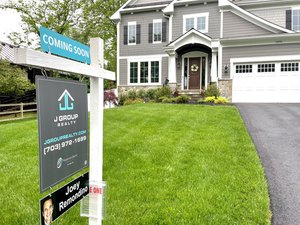Whether you're planning a complete home makeover, refreshing your space, shopping for a new home, or just dreaming of your future home, one of the most exciting things is the idea of adding your personal touch. Your home is a space where you spend a significant amount of time; of course, you want it to show off your personality. Discovering the home design style that speaks to you isn't always straightforward – it requires introspection, exploration, and sometimes a little trial and error. One of the best first steps is to understand the various design styles that exist! In this article, we'll delve into some of the most popular home design styles and hopefully jumpstart your journey toward creating a home that feels uniquely yours.
Traditional Design
Homes featuring a Traditional Design style are sometimes referred to as dated when in reality, they are just a timeless aesthetic. This style of design dates back to the 18th century and draws its inspiration from the English and French homes of the time. These homes are characterized by detailed woodworking and elegant furnishings. Some highlights of the traditional design style are:
Color and Texture: Use of warm, rich colors with various textures such as wood, glass, and other natural materials.
Furniture: Antiques or replica pieces, often in dark wood, with detailed craftsmanship.
Layout: Focus on symmetry, balance, and creating a formal atmosphere.
Decor: Use of classic art, heavy drapes, ornate rugs, and plush, luxurious fabrics.
Transitional Design
As the name suggests, transitional design blends traditional and modern elements to balance the extravagant traditional design and the simplicity of modern design. For those who love traditional houses but want to see them updated to modern times, this is the design style for you! Some highlights of the transitional design style are:
Color and Texture: The color palette is generally neutral and subtle, using textures to add interest and depth.
Furniture: Furniture lines are simple yet sophisticated, featuring straight lines or rounded profiles.
Layout: The layout favors a mix of masculine and feminine design elements with a focus on comfort and practicality. This style often employs an open floor plan for a light, airy feel.
Decor: Accessories are kept to a minimum to maintain a clean, relaxed space. Use of abstract art, textured fabrics like velvet, silk or wool, and accents in chrome, steel or glass to add a luxurious touch.
Modern Design
The term 'modern' in design refers to a period that originated in the early to mid-20th century. Modern design is the sleek, clean, and minimalist aesthetic that we see across social media and real estate reality TV. Though it is often confused with the term "contemporary design," modern design is its own distinct style. Some highlights of the modern design style are:
Color and Texture: Utilizes a neutral color palette, clean lines, and smooth surfaces.
Furniture: Functionality is prioritized, with pieces often made of steel, glass, or chrome.
Layout: Open floor plans and large windows for an abundance of natural light.
Decor: Minimal ornamentation, use of geometric shapes, and art pieces with abstract patterns.
Contemporary Design
Often used interchangeably with "modern" design, contemporary design actually refers to the style of the moment, making it fluid and hard to pin down. This design style represents the style of the present era and is continually evolving to reflect current trends. Some highlights of the contemporary design style are:
Color and Texture: Tends to stick to a neutral palette but occasionally includes a burst of bold color.
Furniture: A mix of straight and rounded lines, often with a sleek, smooth finish.
Layout: Emphasizes open spaces, natural light, and strong, clean lines.
Decor: Incorporates eco-friendly materials, natural elements, and state-of-the-art technology.
Mid-Century Modern Design
Mid-Century Modern homes are a blast from the past in the best way! Over the past few years, this design style has gained a significant amount of popularity, highlighting the nostalgia for retro design. Mid-century modern originates from the mid-1940s to the mid-1960s. This style often uses innovative materials and merges indoor and outdoor living, a concept we can attribute to the influence of Frank Lloyd Wright's designs. Some highlights of the Mid-Century Modern design style are:
Color and Texture: Mix of neutral and saturated colors and a variety of textures and materials.
Furniture: Functional pieces with organic shapes, often made from new materials of the era such as plastic, plywood, and vinyl.
Layout: Open floor plans, lots of windows, and integration with nature.
Decor: Minimalist ornamentation, bold geometric patterns, and iconic pieces like the Eames chair or Noguchi table.
Modern Farmhouse Design
Farmhouse and Modern Farmhouse Design are other examples of design styles that have taken American homes by storm over the past few years. The modern farmhouse style is a contemporary take on the classic farmhouse style, combining the warmth and homey vibes of traditional Farmhouse design with a sleek contemporary twist. This style first became popular in the late 2010s. Some highlights of the Modern Farmhouse design style are:
Color and Texture: Generally utilizes a neutral color palette, often in shades of white, beige, and grey. Accents of natural wood and black or dark metal are also common.
Furniture: Furniture pieces are often a mix of old and new, representing both comfort and simplicity. Distressed or reclaimed wood pieces can be contrasted with sleek, modern furniture.
Layout: Emphasizes open and spacious floor plans. The layout is often practical and functional, creating an inviting and comfortable atmosphere.
Decor: Characteristic elements include shiplap walls, exposed wooden beams, large industrial lighting fixtures, and a mix of old and new decor elements. This style often incorporates modern appliances and amenities paired with traditional architectural details, creating a balance between new and old.
Tudor Design
The Tudor style is named after the Tudor Dynasty in England (1485-1603) and became popular in the United States in the early 20th century. Tudor homes are notable for their distinct historical style that brings you back to a much simpler time. Some highlights of the Tudor design style are:
Color and Texture: This style tends to have dark, rich color palettes and heavy use of wood, both for structural purposes and for decoration.
Furniture: Furniture is typically large and robust, often with intricate carvings or embellishments.
Layout: Features multi-gabled roofs, tall mullioned windows, and large stone chimneys. Interiors may have several small rooms rather than an open floor plan.
Decor: Common elements include leaded glass windows, high ceilings, wall tapestries, and wrought iron or heavy wood accents.
Victorian Design
The Victorian style is named after the reign of Queen Victoria (1837-1901) and is known for its eclectic reinterpretation of past styles and strong sense of ornamentation. These elaborate and ornate homes are gems from the past and are often popular among maximalists. Some highlights of the Victorian design style are:
Color and Texture: Early Victorian color schemes were usually quite muted, while later Victorians enjoyed brighter, richer colors. Wallpaper and wallcoverings were used extensively, often with elaborate patterns.
Furniture: Victorian furniture is known for its ornate carvings, dark woods, and heavy embellishments.
Layout: Rooms are typically small and compartmentalized, each serving a specific purpose, with intricate layouts and asymmetrical floor plans.
Decor: Victorians loved displaying their wealth and taste, so rooms were filled with furniture, knickknacks, and artwork. Popular details included ornate mirrors, stained glass windows, lush fabrics, and detailed tilework.
French Country Design
French Country design is a style that captures the beauty and casual elegance of rural France. It's a blend of old-world charm and rustic simplicity, drawing its inspiration from the rolling hills and tranquil countryside of Provence. Some highlights of the French Country design style are:
Color and Texture: This style favors a warm, earthy color palette inspired by the Provençal landscape. Textures are natural and rustic, with a mix of stone, wood, and clay.
Furniture: Furniture pieces are often sturdy and ornate, featuring rustic wood and distressed finishes. Upholstered pieces typically feature natural fabrics like cotton and linen in muted tones.
Layout: The layout is welcoming and comfortable, designed for casual living. It often features large open fireplaces, high ceilings with wooden beams, and large, open kitchens.
Decor: Typical elements include rustic wood and wrought iron furnishings, toile fabrics, large armoires, and vintage accents. Provence-inspired motifs such as lavenders, sunflowers, olives, and roosters are commonly used.
Industrial Design
With roots in the warehouse and factory conversions of the 1990s, industrial design showcases raw, unfinished looks and materials. Industrial design is a bold statement of simplicity and function, celebrating the beauty found within raw textures and structural elements. Some highlights of the Industrial design style are:
Color and Texture: Raw, unfinished look with exposed brick, metal, and ductwork.
Furniture: Old factory and laboratory pieces, reclaimed wood, and metal details.
Layout: Spacious, open floor plans, high ceilings, and functional elements.
Decor: Old signage, commercial lighting, and vintage accessories.
These home design styles are merely the tip of the iceberg when it comes to exploring the architectural and interior design world. Each style has its own character, aesthetics, and principles. In the end, your chosen design style should be a reflection of your personality and fit your lifestyle! To see more photos of the gorgeous Virginia homes used as examples in this article, click here!
















